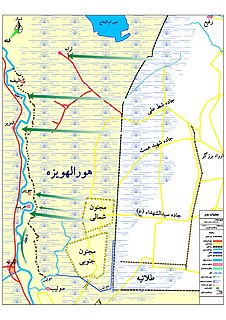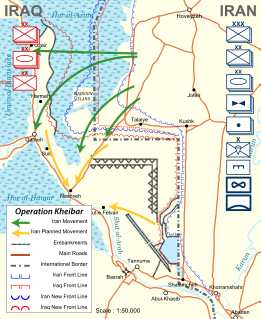 W
WThe Second Battle of al-Faw, fought on 17 April 1988, was a major battle of the Iran–Iraq War. After their defeat at the First Battle of al-Faw two years earlier, the newly restructured Iraqi Army conducted a major operation to clear the Iranians out of the peninsula.
 W
WThe Anfal genocide was a genocide that killed between 50,000 and 182,000 Kurds as well as several thousand Assyrians. It was committed during the Al-Anfal campaign led by Ali Hassan al-Majid, on the orders of President Saddam Hussein, against Iraqi Kurdistan in northern Iraq during the final stages of the Iran–Iraq War.
 W
WOperation Badr was an Iranian operation conducted during the Iran–Iraq War against the forces of Ba'athist Iraq. The Iranians launched their offensive on March 11 and succeeded in capturing a part of the Basra-Amarah-Baghdad highway. The following Iraqi counterattack, however, forced the Iranians out in a continual war of endless stalemate.
 W
WOn 9 January 1987, at the beginning of the Battle of Shalamcheh, in the midst of the Iran–Iraq War, the Iranian Behbehan Battalion came under a heavy aerial chemical bomb attack by Iraqi forces. The Behbahan Battalion was positioned near Shalamcheh, in the south of Iran, about 10 km from the port of Khorramshahr.
 W
WIraq, on June 28, 1987, dropped what Iranian authorities believed to be mustard gas bombs on Sardasht, West Azerbaijan, in two separate bombing runs on four residential areas. The numbers of victims were initially estimated as 10 civilians dead and 650 civilians injured.
 W
WIraq chemical attacks against Iran refers to chemical attacks used by the Iraqi armed forces against Iranian combatants and non-combatants. The Iraqi armed forces employed chemical weapons against combatants and non-combatants in border cities and villages and more than 30 attacks against Iranian civilians were reported. There were chemical attacks against some medical centers and hospitals by the Iraqi army. According to a 2002 article in the Star-Ledger, 20,000 Iranian combatants and combat medics were killed on the spot by nerve gas. As of 2002, 5,000 of the 80,000 survivors continue to seek regular medical treatment, while 1,000 are hospital inpatients. According to the Geneva Protocol, chemical attacks were banned, but in practice, to prevent an Iranian victory, the United States supported the Iraqi army in their use of chemical weapons.
 W
WThe Siege of Basra, code-named Operation Karbala-5 or The Great Harvest, was an offensive operation carried out by Iran in an effort to capture the Iraqi port city of Basra in early 1987. This battle, known for its extensive casualties and ferocious conditions, was the biggest battle of the war and proved to be the beginning of the end of the Iran–Iraq War. The Iranians failed to reach their objective.
 W
WOperation Kheibar was an Iranian offensive in the Iran–Iraq War. It was part of the Battle of the Marshes.